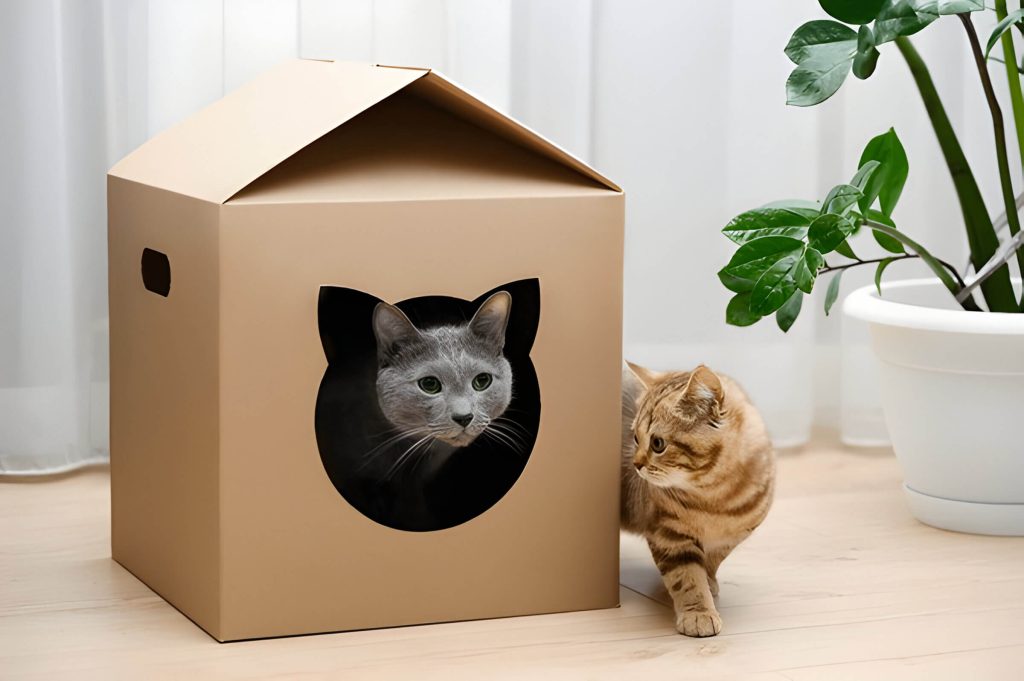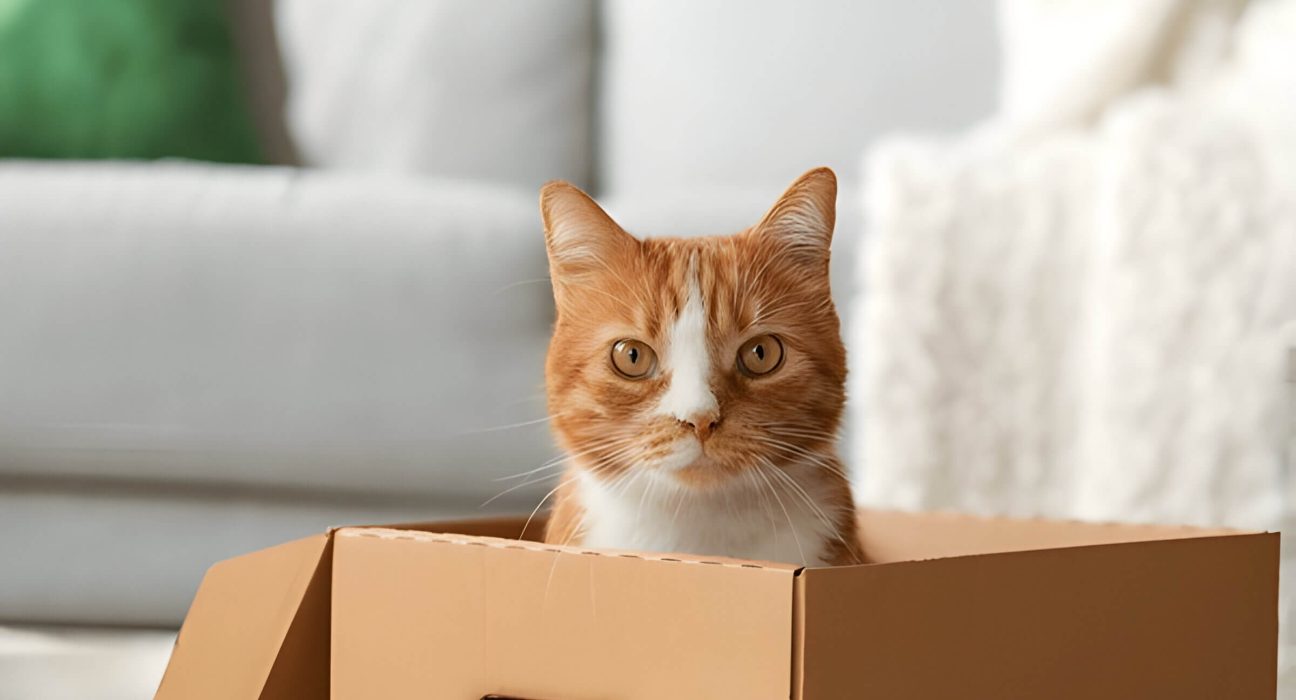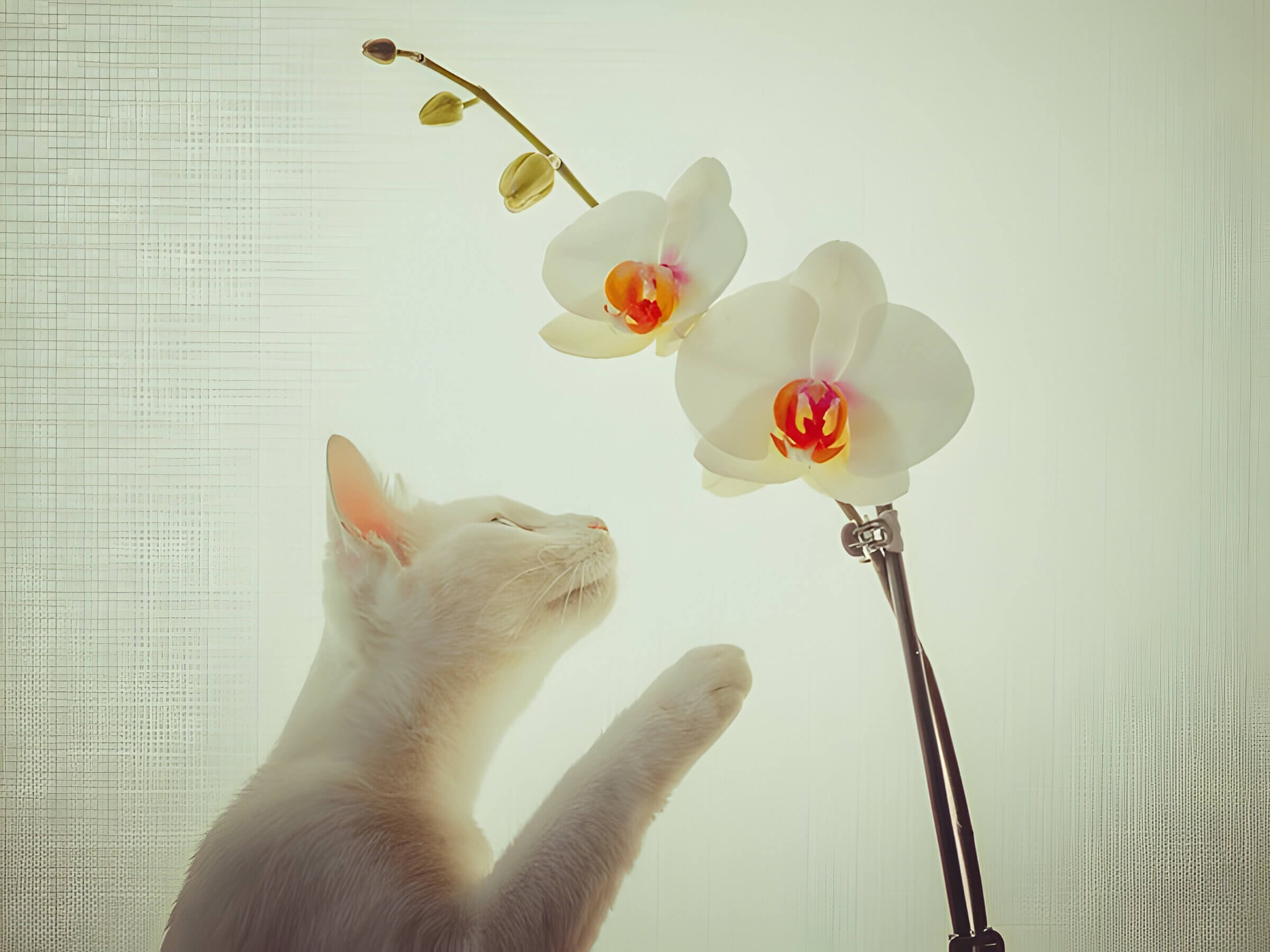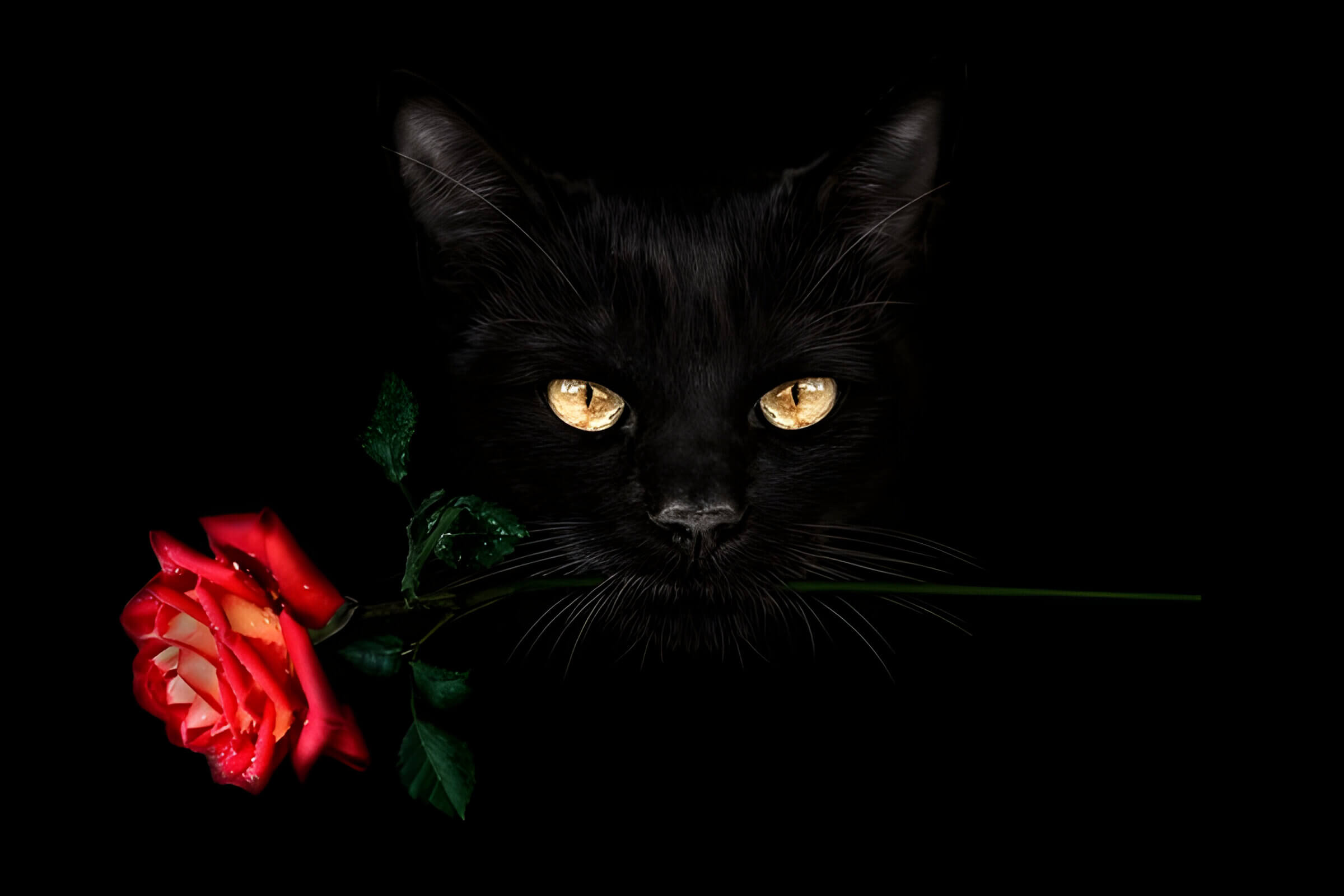Have you ever wondered, “Why do cats like boxes?” This seemingly quirky behaviour is more than just a cute internet meme. It’s a fascinating insight into feline psychology and instincts. From providing a sense of security to satisfying predatory urges, boxes serve multiple purposes in a cat’s world. Let’s explore the intriguing reasons behind this common feline obsession and discover how you can use this knowledge to enrich your cat’s environment.
The Instinctive Appeal of Enclosed Spaces
Cats’ affinity for boxes and enclosed spaces is deeply rooted in their instinctive behavior. This peculiar feline trait can be attributed to several factors that stem from their evolutionary history as both predators and prey. Boxes provide cats with a sense of security, offering a safe haven where they can observe their surroundings while remaining hidden. This behavior aligns with their natural instinct to seek out protected areas in the wild.
Moreover, enclosed spaces serve as excellent vantage points for cats to ambush potential prey or perceived threats. This ties into their predatory nature, allowing them to feel in control of their environment. Boxes also act as territory markers, giving cats a defined space they can claim as their own within the household.
The cozy confines of a box can also help regulate a cat’s body temperature, providing warmth and comfort. This is particularly appealing to cats, as they are known to seek out warm spots for rest and relaxation. Additionally, the tight quarters of a box can create a sense of pressure on the cat’s body, which may have a calming effect similar to swaddling in human infants.
Boxes as Stress-Reducers
Boxes serve as more than just playful hideaways for our feline friends; they play a crucial role in reducing cat stress and anxiety. The enclosed space of a box creates a cozy environment that mimics the secure, den-like areas cats naturally seek in the wild. This instinctive desire for confined spaces is deeply rooted in their evolutionary history, where such hideouts provided safety from predators.
When a cat retreats to a box, it enters its own personal feline comfort zone. The walls of the box provide a sense of security, allowing the cat to observe its surroundings while feeling protected. This feeling of safety significantly contributes to cat relaxation, helping to lower stress levels and promote a sense of well-being.
Research has shown that cats in shelters provided with boxes exhibit lower stress levels compared to those without. This demonstrates the powerful effect these simple cardboard structures can have on feline mental health. The “why do cats like boxes” question can largely be answered by understanding this stress-relief mechanism.
By offering your cat access to boxes, you’re not just providing a toy, but a valuable tool for anxiety reduction. Whether it’s a new environment, loud noises, or other stressors, a box can offer your cat a retreat where it feels safe and calm. This simple addition to your home can significantly enhance your cat’s quality of life and overall happiness.
Boxes as Hunting Grounds
Cats are natural-born hunters, and their predatory instincts remain strong even in domesticated environments. The allure of boxes for cats goes beyond mere comfort; these cardboard havens serve as perfect hunting grounds, tapping into their innate ambush predator behavior. When a cat crouches inside a box, it mimics the stealthy approach of a wild feline stalking its prey in tall grass or dense underbrush.
This play behavior is not only entertaining for cats but also crucial for their mental and physical well-being. Boxes provide environmental stimulation, allowing cats to engage in mock hunts that satisfy their predatory drive. As they pounce on toys or unsuspecting human feet from their cardboard fortress, cats are essentially practicing their hunting skills and keeping their reflexes sharp.
Feline enrichment through box play helps prevent boredom and reduces stress in indoor cats. By providing boxes of various sizes and arrangements, cat owners can create an ever-changing landscape that keeps their feline companions engaged and stimulated. This simple yet effective form of environmental enrichment taps into cats’ natural instincts, promoting both physical activity and mental acuity.
Understanding and nurturing these predatory instincts through box play is an important aspect of responsible cat ownership, ensuring that our feline friends remain happy, healthy, and mentally stimulated in their domestic habitats.
Boxes as Temperature Control
Cats are masters of thermoregulation, and boxes play a crucial role in helping them maintain their ideal body temperature. The insulation properties of cardboard make boxes excellent tools for heat conservation. A cat’s normal body temperature ranges from 100.5°F to 102.5°F (38°C to 39.2°C), and they expend considerable energy to maintain this range.
Cardboard boxes act as natural insulators, trapping a layer of warm air around the cat’s body. This insulation effect is particularly beneficial in cooler environments, allowing cats to conserve energy that would otherwise be used for generating body heat. The enclosed space of a box also provides a sense of security, reducing stress and helping cats relax, which in turn aids in efficient thermoregulation.
Interestingly, the insulation properties of cardboard work both ways. In warmer climates, boxes can offer a cooler microclimate compared to the surrounding air, especially if placed in a shaded area. This versatility makes boxes an invaluable tool for feline thermoregulation across various environmental conditions.
Understanding this aspect of feline behavior can help cat owners provide better care for their pets, ensuring they have access to boxes or similar enclosed spaces to assist with their natural temperature regulation needs.
Boxes as New Territory
Cats are naturally curious creatures, and their fascination with boxes serves as a perfect example of their innate desire to explore new territories. This behavior is deeply rooted in their instincts for environmental enrichment and seeking novel stimuli. When a cat encounters a box, it represents an unexplored space that appeals to their sense of adventure.
Feline exploration is a crucial aspect of their well-being, as it provides both mental and physical stimulation. Boxes offer a multisensory experience for cats, engaging their sense of touch, smell, and sight. The confined space of a box also provides a sense of security, allowing cats to observe their surroundings from a protected vantage point.
Introducing new boxes or changing their locations can serve as a form of sensory stimulation for indoor cats. This simple act can help prevent boredom and encourage natural behaviors. As cat owners, understanding and nurturing this curiosity can contribute significantly to our feline companions’ overall happiness and cognitive health.
The Role of Texture and Sound in Box Appeal
The texture and sound of a box play a crucial role in its appeal to cats, engaging their natural instincts and sensory preferences. Cardboard’s unique texture provides an ideal surface for scratching, satisfying a cat’s innate need to maintain claw health and mark territory. The coarse fibers offer resistance, mimicking tree bark, which cats find irresistible.
Auditory stimulation is another key factor in a box’s allure. The sound produced when cats scratch or paw at cardboard can be highly engaging, encouraging further interaction. This auditory feedback reinforces the cat’s interest and prolongs their play session.
Cats also exhibit distinct tactile preferences, often favoring surfaces that provide a balance between softness and firmness. Cardboard’s texture falls within this sweet spot, offering a comfortable yet stimulating sensory experience. The combination of texture and sound creates a multi-sensory attraction that keeps cats coming back to their cardboard havens.
Understanding these sensory aspects can help cat owners select or create boxes that maximize their feline friends’ enjoyment, promoting both physical activity and mental stimulation.
How to Use Boxes to Enhance Your Cat’s Environment

Boxes can be an excellent tool for enhancing your cat’s environment, providing both entertainment and comfort. As natural explorers, cats are drawn to enclosed spaces, making boxes an ideal and cost-effective way to create feline-friendly spaces in your home.
Start by repurposing cardboard boxes as DIY cat enrichment tools. Cut holes of various sizes in the sides to create hiding spots and peek-a-boo games. You can also stack multiple boxes to form a multi-level playground, encouraging your cat’s natural climbing instincts.
For a cozy retreat, transform a sturdy box into a homemade cat bed by lining it with soft blankets or towels. This provides a safe space for your cat to relax and observe their surroundings.
To add an element of surprise, occasionally place cat toys inside boxes or create puzzle feeders by hiding treats in crumpled paper within a box. This stimulates your cat’s hunting instincts and provides mental stimulation.
Remember to rotate and replace boxes regularly to maintain your cat’s interest and ensure a clean, safe environment. By incorporating boxes into your cat’s daily life, you’re providing simple yet effective environmental enrichment that caters to their natural behaviors and preferences.







